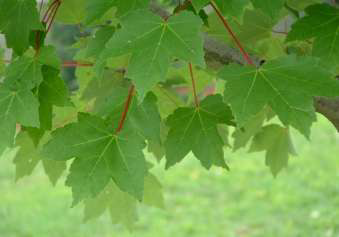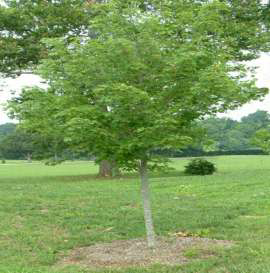 Red Maple
Red Maple
(Acer rubrum L.)
|
Classification |
| Kingdom: |
Plantae |
| Division: |
Magnoliophyta |
| Class: |
Magnoliopsida |
| Order: |
Sapindales |
| Family: |
Sapindaceae |
| Genus: |
Acer |
| Species: |
rubrum |
 Characteristics: The Red Maple tree has a rounded and compact crown. It reaches heights of 60 to 90 feet with an average trunk diameter of 2.5 feet. The bark is gray, thin and smooth, developing into long scaly ridges as the tree matures. The leaves are 2.5 to 4 inches in length and broadly ovate, with 3 shallow short-pointed lobes. The edges are wavy, serrate and have a long red or green leaf stalk. The leaves are dull green above and whitish and hairy beneath. The fruit are ¾ to 1 inch long. They have long wing and contain one seed. The long wing aids in wind-disseminated seed dispersal.
Characteristics: The Red Maple tree has a rounded and compact crown. It reaches heights of 60 to 90 feet with an average trunk diameter of 2.5 feet. The bark is gray, thin and smooth, developing into long scaly ridges as the tree matures. The leaves are 2.5 to 4 inches in length and broadly ovate, with 3 shallow short-pointed lobes. The edges are wavy, serrate and have a long red or green leaf stalk. The leaves are dull green above and whitish and hairy beneath. The fruit are ¾ to 1 inch long. They have long wing and contain one seed. The long wing aids in wind-disseminated seed dispersal.
Habitat: Red maple grows well in wet or moist soils, such as stream banks, valleys, and swamps. However it can also inhabit uplands and sometimes dry ridges. Red maple is often found in mixed hardwood forests.
Range: It can be found from southeast Manitoba to east Newfoundland, and south Florida to east Texas.
Native American Uses: An infusion of the bark was taken for cramps, hives, and dysentery. The inner bark was boiled and used with water as wash for sore eyes. In addition, a hot infusion of bark was given for measles. Finally, red maple was used to make baskets, building materials, furniture, and carvings. The Cherokee Indians are among the Native American tribes to utilize this species.
Colonial Uses: Colonists made ink and cinnamon-brown or black dye from the bark extract.
Modern Uses: Today, Red Maple is predominantly planted because it is an attractive shade tree, with bright red foliage in the fall, but its sap can also be made into a sugary syrup.